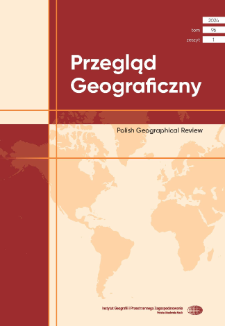- Wyszukaj w całym Repozytorium
- Piśmiennictwo i mapy
- Archeologia
- Baza Młynów
- Nauki przyrodnicze
Wyszukiwanie zaawansowane
Wyszukiwanie zaawansowane
Wyszukiwanie zaawansowane
Wyszukiwanie zaawansowane
Wyszukiwanie zaawansowane

Obiekt
Tytuł: Jakość Internetu w Polsce na poziomie lokalnym w kontekście inteligentnego rozwoju wsi = Internet quality at the local level in Poland, in the context of smart rural development
Inny tytuł:
Przegląd Geograficzny T. 96 z. 1 (2024)
Wydawca:
Miejsce wydania:
Opis:
Abstrakt:
Na obszarach wiejskich w Europie zachodzą intensywne procesy przemian, będące wynikiem rozwoju społeczeństwa opartego na usługach oraz gospodarki opartej na wiedzy. W rezultacie, znaczna część wsi doświadcza tzw. „kryzysu wiejskiego”. Jednym z proponowanych rozwiązań tego problemu jest koncepcja inteligentnego rozwoju (smart development), podkreślająca wzrastające znaczenie wiedzy i kluczową rolę technologii cyfrowych w procesach rozwoju. Celem artykułu jest identyfikacja kluczowych cech zróżnicowania przestrzennego jakości Internetu w Polsce oraz wskazanie współzależności tego zjawiska z poziomem rozwoju społeczno-ekonomicznego. Jakość Internetu (zarówno stałego, jak i mobilnego) została opisana na podstawie danych dotyczących prędkości Internetu na poziomie gminnym, a analizy przeprowadzono w kontekście koncepcji inteligentnego rozwoju obszarów wiejskich. W badaniu zastosowano metodę składowych głównych oraz analizę współczynników korelacji. W wyniku przeprowadzonej procedury badawczej ujawniono istotne różnice w jakości Internetu (stałego i mobilnego) pomiędzy gminami miejskimi a wiejskimi. Jednakże, rozkład przestrzenny zmiennych opisujących jakość Internetu wykazał również obszary o podobnej jakości połączenia, niezależnie od rodzaju gminy. Dodatkowo, analiza korelacji pozwoliła określić wzajemne zależności pomiędzy jakością Internetu a fundamentalnymi cechami opisującymi poziom rozwoju społeczno-ekonomicznego badanych obszarów.
Bibliografia:
Ahlmeyer, F., & Volgmann, K. (2023). What Can We Expect for the Development of Rural Areas in Europe? -Trends of the Last Decade and Their Opportunities for Rural Regeneration. Sustainability, 15(6), 5485. https://doi.org/10.3390/su15065485
![]()
Ball, M. (2022). The Metaverse: And How It Will Revolutionize Everything. Nowy Jork: Liveright Publishing.
![]()
Barnes, S.J. (2020). Information management research and practice in the post-COVID-19 world. International Journal of Information Management, 102175. https://doi.org/10.1016/j.ijinfomgt.2020.102175
![]()
Bauer, S., Clark, D.D., & Lehr, W. (2010). Understanding Broadband Speed Measurements. TPRC 2010. Pobrane z: https://ssrn.com/abstract=1988332 (06.05.2023).
Bourgeois, R. (2015). What future for rural areas? Seven plausible rural transformations. Development, 58(2‑3), 177‑186. https://doi.org/10.1057/s41301-016-0017-1
![]()
Bronzino, F., Feamster, N., Liu, S., Saxon, J., & Schmitt, P. (2021). Mapping the digital divide: before, during, and after COVID-19. TPRC48: The 48th Research Conference on Communication, Information and Internet Policy (s. 1‑11). Pobrane z: https://ssrn.com/abstract=3786158 (06.05.2023).
![]()
Brown, A., & Kristiansen, A. (2009). Urban Politics and the Right to the City: Rights, Responsibilities and Citizenship. MOST-2 Policy Paper Series. Pobrane z: https://www.hic-net.org/content/urban%20policies-R2C.pdf
Budnitz, H., & Tranos, E. (2022). Working from home and digital divides: resilience during the pandemic. Annals of the American Association of Geographers, 112(4), 893‑913. https://doi.org/10.1080/24694452.2021.1939647
![]()
Caldas, M.P., Veneri, P., & Marshalian, M. (2023). Assessing spatial disparities in Internet quality using speed tests. OECD Regional Development Papers No. 47. https://doi.org/10.1787/77c42f5e-en
![]()
Cambra‐Fierro, J.J., & Pérez, L. (2022). (Re) thinking smart in rural contexts: A multi‐country study. Growth and Change, 53(2), 868‑889. https://doi.org/10.1111/grow.12612
![]()
Chapman, R., & Slaymaker, T., (2002). ICTs and rural development: review of the literature, current interventions and opportunities for action. ODI Working Papers 192. Londyn: Overseas Development Institute (ODI). Pobrane z: https://odi.org/en/publications/icts-and-rural-development-review-of-the-literature-current-interventions-and-opportunities-for-action/ (06.05.2023).
Chiou, L., & Tucker, C. (2020). Social distancing, internet access and inequality (No. w26982). National Bureau of Economic Research. Pobrane z: https://ideas.repec.org/p/nbr/nberwo/26982. html (06.05.2023).
![]()
Copus, A.K., Shucksmith, M., Dax, T., & Meredith, D. (2011). Cohesion Policy for rural areas after 2013. A rationale derived from the EDORA project (European Development Opportunities in Rural Areas) - ESPON 2013 Project 2013/1/2. Studies in Agricultural Economics, 2, 121‑132. http://doi.org/10.22004/ag.econ.119647
![]()
Courtois, C., & Verdegem, P. (2016). With a little help from my friends: An analysis of the role of social support in digital inequalities. New Media & Society, 188, 1508‑1527. https://doi.org/10.1177/1461444814562162
![]()
Cullinan, J., Flannery, D., Harold, J., Lyons, S., & Palcic, D. (2021). The disconnected: COVID-19 and disparities in access to quality broadband for higher education students. International Journal of Educational Technology in Higher Education, 18(1), 1‑21. https://doi.org/10.1186/s41239-021-00262-1
![]()
Czapiewski, K. (2010). Koncepcja wiejskich obszarów sukcesu społeczno-gospodarczego i ich rozpoznanie w województwie mazowieckim. Studia Obszarów Wiejskich, XXII. Warszawa: PTG, IGiPZ PAN.
Czapiewski, K.Ł., & Janc, K. (2011). Accessibility to Education and its Impact on Regional Development in Poland. W: N. Adams, G. Cotella, & R. Nunes (red.), Territorial Development, Cohesion and Spatial Planning. Knowledge and policy development in an enlarged EU (s. 345‑372). Oxon: Routledge.
Farrington, J., Philip, L., Cottrill, C., Abbott, P., Blank, G., & Dutton, W.H. (2015). Two-speed Britain: Rural internet use. Aberdeen University Press. https://doi.org/10.2139/ssrn.2645771
![]()
Floriańczyk, Z., Janc, K., & Czapiewski, K. (2012). The importance and diffusion of knowledge in the agricultural sector: the Polish experience. Geographia Polonica, 83(1), 45‑56. https://doi.org/GPol.2012.1.4
![]()
Ford, G.S. (2022). Speed-Tests: Substitute for, or Complement to, Broadband Maps? Phoenix Center Perspectives, 22‑05. Pobrane z: https://ssrn.com/abstract=4251557 (02.03.2023).
Graves, J.M., Abshire, D.A., Amiri, S., & Mackelprang, J.L. (2021). Disparities in technology and broadband internet access across rurality: implications for health and education. Family & Community Health, 44(4), 257. https://doi.org/10.1097/fch.0000000000000306
![]()
Grubesic, T.H., & Mack, E.A. (2015). Broadband telecommunications and regional development. Nowy Jork: Routledge.
![]()
Janc, K. (2019). Przestrzeń cyfrowa i internet jako przedmiot zainteresowań w badaniach geograficznych. Przegląd Geograficzny, 91(2), 21‑37. https://doi.org/10.7163/PrzG.2019.2.2
![]()
Janc, K., & Czapiewski, K. (2013). The Internet as a development factor of rural areas and agriculture. Studia Regionalia KPZK PAN, 36, 89‑105.
Janc, K., & Jurkowski, W. (2022). Przestrzenne zróżnicowanie jakości Internetu w aspekcie wykluczenia cyfrowego w Polsce. Prace Komisji Geografii Komunikacji PTG, 1, 73‑84. http://doi.org/10.4467/2543859XPKG.22.002.15962
![]()
Janc, K., Czapiewski, K., & Wójcik, M. (2019). In the starting blocks for smart agriculture: The Internet as a source of knowledge in transitional agriculture. NJAS - Wageningen Journal of Life Sciences, 90-91, 1‑18. https://doi.org/10.1016/j.njas.2019.100309
![]()
Janc, K., Ilnicki, D., & Jurkowski, W. (2022). Spatial regularities in Internet performance at a local scale: The case of Poland. Moravian Geographical Reports, 30(3), 163‑178. https://doi.org/10.2478/mgr-2022-0011
![]()
Kalinowski, S., Komorowski, Ł., & Rosa, A. (2021). Koncepcja smart villages. Przykłady z Polski. Warszawa: Instytut Rozwoju Wsi i Rolnictwa PAN.
![]()
Kitchin, R. (2014). The real-time city? Big data and smart urbanism. GeoJournal, 79(1), 1‑14. https://doi.org/10.1007/s10708-013-9516-8
![]()
Komorowski, Ł., & Stanny, M. (2020). Smart villages: Where can they happen? Land, 9(5), 151. https://doi.org/10.3390/land9050151
![]()
Kongaut, C., & Bohlin, E. (2017). Impact of broadband speed on economic outputs: An empirical study of OECD countries. Economics and Business Review, 3(2), 12‑32. http://doi.org/10.18559/ebr.2017.2.2
![]()
Kuhmonen, T., & Kuhmonen, I. (2015). Rural futures in developed economies: The case of Finland. Technological Forecasting and Social Change, 101, 366‑374. https://doi.org/10.1016/j.techfore.2015.07.028
![]()
Kumar, V.T.M., & Dahiya, B. (2017). Smart Economy in Smart Cities. W: Kumar, V.T.M. (red.), Smart Economy in Smart Cities: International Collaborative Research: Ottawa, St. Louis, Stuttgart, Bologna, Cape Town, Nairobi, Dakar, Lagos, New Delhi, Varanasi, Vijayawada, Kozhikode, Hong Kong (s. 3‑76). Singapur: Springer. https://doi.org/10.1007/978-981-10-1610-3_1
![]()
Lai, J., & Widmar, N.O. (2020). Revisiting the Digital Divide in the COVID-19 Era. Applied Economic Perspectives and Policy, 43(1), 458‑464. https://doi.org/10.1002/aepp.13104
![]()
Li, Y., Westlund, H., & Liu, Y. (2019). Why some rural areas decline while some others not: An overview of rural evolution in the world. Journal of Rural Studies, 68, 135‑143. https://doi.org/10.1016/j.jrurstud.2019.03.003
![]()
Llorent-Bedmar, V., Palma, V.C.C.D., & Navarro-Granados, M. (2021). The rural exodus of young people from empty Spain. Socio-educational aspects. Journal of Rural Studies, 82, 303‑314. https://doi.org/10.1016/j.jrurstud.2021.01.014
![]()
Lobato, R. (2019). Netflix nations. New York: New York University Press.
![]()
Lüdering, J.W. (2015). The measurement of internet availability and quality in the context of the discussion on the digital divide (Discussion Paper No. 65). Justus-Liebig-Universität Gießen, Zentrum für Internationale Entwicklungs- und Umweltforschung ZEU. Pobrane z: https://www.econstor.eu/bitstream/10419/119872/1/835443345.pdf (02.03.2023).
Malik, P.K., Singh, R., Gehlot, A., Akram, S.V., & Das, P.K. (2022). Village 4.0: Digitalization of village with smart internet of things technologies. Computers & Industrial Engineering, 165, 107938.https://doi.org/10.1016/j.cie.2022.107938
![]()
McCann, P., & Ortega-Argilés, R. (2015). Smart specialization, regional growth, and applications to European Union cohesion policy. Regional Studies, 49(8), 1291‑1302. https://doi.org/10.1080/00343404.2013.799769
![]()
Naldi, L., Nilsson, P., Westlund, H., & Wixe, S. (2015). What is smart rural development. Journal of Rural Studies, 40, 90‑101. https://doi.org/10.1016/j.jrurstud.2015.06.006
![]()
Ozili, P.K., & Arun, T. (2023). Spillover of COVID-19: Impact on the global economy. W: U. Akkucuk (red.), Managing inflation and supply chain disruptions in the global economy (s. 41‑61). Hershey: IGI Global.
![]()
Paul, U., Liu, J., Adarsh, V., Gu, M., Gupta, A., & Belding, E. (2021). Characterizing performance inequity across US Ookla Speedtest users. Pobrane z: https://doi.org/10.48550/arXiv.2110.12038 (06.05.2023).
![]()
Pělucha, M. (2019). Smart villages and investments to public services and ICT infrastructure: case of the Czech rural development program 2007‑2013. European Countryside, 11(4), 584‑598. https://doi.org/10.2478/euco-2019-0032
![]()
Pělucha, M., & Kasabov, E. (2019). Rural development in the digital age: exploring neo-productivist EU rural policy. Oxon: Routledge.
![]()
Pemberton, S. (2019). Rural regeneration in the UK. Oxon: Routledge.
![]()
Philip, L.J., Cottrill, C., & Farrington, J. (2015). 'Two-speed' Scotland: Patterns and implications of the digital divide in contemporary Scotland. Scottish Geographical Journal, 131(3‑4), 148‑171. https://doi.org/10.1080/14702541.2015.1067327
![]()
Prieger, J.E. (2003). The supply side of the digital divide: Is there equal availability in the broadband Internet access market? Economic Inquiry, 41(2), 346‑363. https://doi.org/10.1093/ei/cbg013
![]()
Riddlesden, D., & Singleton, A.D. (2014). Broadband speed equity: A new digital divide? Applied Geography, 52, 25‑33. https://doi.org/10.1016/j.apgeog.2014.04.008
![]()
Rifkin, J. (2014). The zero marginal cost society: The internet of things, the collaborative commons, and the eclipse of capitalism. New York: St. Martin's Press.
Rusten, G., & Skerratt, S. (2008). Being rural in a digital age. W: G. Rusten & S. Skerratt (red.), Information and Communication Technologies in Rural Society. Being rural in a digital age (s. 1‑16). Oxon: Routledge.
![]()
Salemink, K., Strijker, D., & Bosworth, G. (2017). Rural development in the digital age: A systematic literature review on unequal ICT availability, adoption, and use in rural areas. Journal of Rural Studies, 54, 360‑371. https://doi.org/10.1016/j.jrurstud.2015.09.001
![]()
Sanders, C.K., & Scanlon, E. (2021). The digital divide is a human rights issue: Advancing social inclusion through social work advocacy. Journal of Human Rights and Social Work, 6(2), 130‑143. https://doi.org/10.1007/s41134-020-00147-9
![]()
Saxon, J., & Black, D.A. (2022). What we can learn from selected, unmatched data: Measuring Internet inequality in Chicago. Computers, Environment and Urban Systems, 98, 101874. https://doi.org/10.1016/j.compenvurbsys.2022.101874
![]()
Stein, V., & Pentzold, C. (2023). Perspectives for Digital Participation in Rural Areas: Evidence from German Regions. W: A. Lorenz & L.H. Anders (red.), EU Citizenship Beyond Urban Centres: Perceptions and Practices of Young People in East Central European Peripheral Areas (s. 215‑224). Cham: Springer International Publishing.
![]()
Stein, V., Pentzold, C., Peter, S., & Sterly, S. (2022). Digitalization and Civic Participation in Rural Areas. A Systematic Review of Scientific Journals, 2010‑2020. Raumforschung und Raumordnung/ Spatial Research and Planning, 80(3), 251‑265. https://doi.org/10.14512/rur.112
![]()
Stocker, V., Lehr, W., & Smaragdakis, G. (2023). COVID-19 and the Internet: Lessons learned. W: J. Whalley, V. Stocker & W. Lehr (red.), Beyond the Pandemic? Exploring the Impact of COVID-19 on Telecommunications and the Internet (s. 17‑69). Bingley: Emerald Publishing Limited.
![]()
Sun, H. (2020). Bridging the Digital Chasm through the Fundamental Right to Technology. Georgetown Journal on Poverty Law & Policy, 28. University of Hong Kong Faculty of Law Research Paper #2021/018. Pobrane z: https://ssrn.com/abstract=3845905 (02.03.2023).
Święcicki, I. (2021). Nierównomierna jakość dostępu do Internetu w Polsce w dobie pandemii COVID-19. Polski Instytut Ekonomiczny. Pobrane z: https://pie.net.pl/wp-content/uploads/2021/11/PIE-Raport_Nierownomierna-jakosc.pdf (06.05.2023).
Tallon, A. (2010). Urban regeneration in the UK. Oxon: Routledge.
![]()
Toffler, A. (2006). Revolutionary wealth. New York: Knopf.
![]()
UKE, 2023. Raport o stanie rynku telekomunikacyjnego w 2022 roku. Warszawa: Urząd Komunikacji Elektronicznej. Pobrane z: https://www.uke.gov.pl/download/gfx/uke/pl/defaultaktualnosci/36/485/5/uke_raport_tele_2022_2.pdf (06.05.2023).
Vaishar, A., Šťastná, M., Zapletalová, J., & Nováková, E. (2020). Is the European countryside depopulating? Case study Moravia. Journal of Rural Studies, 80, 567‑577. https://doi.org/10.1016/j.jrurstud.2020.10.044
![]()
van Deursen, A., & van Dijk, J.A.G.M. (2014). The digital divide shifts to differences in usage. New Media & Society, 16(3), 507‑526. https://doi.org/10.1177/146144481348
![]()
Vironen, H., & Kah, S. (2019). Meeting the challenges of digitalisation: Implications for regional and rural development. European Policy Research Paper, 111. Glasgow: European Policies Research Centre, University of Strathclyde. Pobrane z: http://eprc-strath.org/wp-content/uploads/2021/09/Meeting-the-Challenges-of-Digitalisation-EPRP-111.pdf (06.05.2023).
Wójcik, M. (2018). Koncepcja inteligentnego rozwoju (smart development) - wyzwanie dla planowania obszarów wiejskich. Acta Universitatis Lodziensis. Folia Geographica Socio-Oeconomica, 31, 5‑15. https://doi.org/10.18778/1508-1117.31.01
![]()
Wójcik, M., Tobiasz-Lis, P., Czapiewski, K., Janc, K., Jeziorska-Biel, P., & Wolski, O. (2018). Inteligentny rozwój obszarów wiejskich (smart rural development): Koncepcja, wymiary, metody. Łódź: GlobalPoint.
Wolski, O., & Wójcik, M. (2019). Smart villages revisited: Conceptual background and new challenges at the local level. W: A. Visvizi, M. Lytras, & G. Mudri (red.), Smart Villages in the EU and Beyond (s. 29‑48). Bingley: Emerald Publishing Limited.
![]()
Czasopismo/Seria/cykl:
Tom:
Zeszyt:
Strona pocz.:
Strona końc.:
Szczegółowy typ zasobu:
Format:
Identyfikator zasobu:
oai:rcin.org.pl:241129 ; 0033-2143 (print) ; 2300-8466 (on-line) ; 10.7163/PrzG.2024.1.2
Źródło:
CBGiOŚ. IGiPZ PAN, sygn.: Cz.181, Cz.3136, Cz.4187 ; kliknij tutaj, żeby przejść
Język:
Język streszczenia:
Prawa:
Licencja Creative Commons Uznanie autorstwa 4.0
Zasady wykorzystania:
Zasób chroniony prawem autorskim. [CC BY 4.0 Międzynarodowe] Korzystanie dozwolone zgodnie z licencją Creative Commons Uznanie autorstwa 4.0, której pełne postanowienia dostępne są pod adresem: ; -
Digitalizacja:
Instytut Geografii i Przestrzennego Zagospodarowania Polskiej Akademii Nauk
Lokalizacja oryginału:
Dofinansowane ze środków:
Programme Innovative Economy, 2010-2014, Priority Axis 2. R&D infrastructure ; European Union. European Regional Development Fund
Dostęp:
Kolekcje, do których przypisany jest obiekt:
- Repozytorium Cyfrowe Instytutów Naukowych > Kolekcje Partnerów > Instytut Geografii i Przestrzennego Zagospodarowania PAN > Publikacje pracowników i Wydawnictw
- Repozytorium Cyfrowe Instytutów Naukowych > Kolekcje Partnerów > Instytut Geografii i Przestrzennego Zagospodarowania PAN > Biblioteka Instytutu > Serie/Czasopisma/Cykle
- Repozytorium Cyfrowe Instytutów Naukowych > Piśmiennictwo > Czasopisma/Artykuły
Data ostatniej modyfikacji:
23 sie 2024
Data dodania obiektu:
14 maj 2024
Liczba pobrań / odtworzeń:
141
Wszystkie dostępne wersje tego obiektu:
https://rcin.org.pl./publication/277476
Wyświetl opis w formacie RDF:
Wyświetl opis w formacie RDFa:
Wyświetl opis w formacie OAI-PMH:
Obiekty Podobne
Banach, Anna Kozakiewicz, Anna Kozakiewicz, Michał Liro, Anna
Floriańczyk, Zbigniew Janc, Krzysztof Czapiewski, Konrad
Borkowska, A. Konopko, A.
Litwiński, Robert
Wąsowska, Monika Gabriela (1954– )

 INSTYTUT ARCHEOLOGII I ETNOLOGII POLSKIEJ AKADEMII NAUK
INSTYTUT ARCHEOLOGII I ETNOLOGII POLSKIEJ AKADEMII NAUK
 INSTYTUT BADAŃ LITERACKICH POLSKIEJ AKADEMII NAUK
INSTYTUT BADAŃ LITERACKICH POLSKIEJ AKADEMII NAUK
 INSTYTUT BADAWCZY LEŚNICTWA
INSTYTUT BADAWCZY LEŚNICTWA
 INSTYTUT BIOLOGII DOŚWIADCZALNEJ IM. MARCELEGO NENCKIEGO POLSKIEJ AKADEMII NAUK
INSTYTUT BIOLOGII DOŚWIADCZALNEJ IM. MARCELEGO NENCKIEGO POLSKIEJ AKADEMII NAUK
 INSTYTUT BIOLOGII SSAKÓW POLSKIEJ AKADEMII NAUK
INSTYTUT BIOLOGII SSAKÓW POLSKIEJ AKADEMII NAUK
 INSTYTUT CHEMII FIZYCZNEJ PAN
INSTYTUT CHEMII FIZYCZNEJ PAN
 INSTYTUT CHEMII ORGANICZNEJ PAN
INSTYTUT CHEMII ORGANICZNEJ PAN
 INSTYTUT FILOZOFII I SOCJOLOGII PAN
INSTYTUT FILOZOFII I SOCJOLOGII PAN
 INSTYTUT GEOGRAFII I PRZESTRZENNEGO ZAGOSPODAROWANIA PAN
INSTYTUT GEOGRAFII I PRZESTRZENNEGO ZAGOSPODAROWANIA PAN
 INSTYTUT HISTORII im. TADEUSZA MANTEUFFLA POLSKIEJ AKADEMII NAUK
INSTYTUT HISTORII im. TADEUSZA MANTEUFFLA POLSKIEJ AKADEMII NAUK
 INSTYTUT JĘZYKA POLSKIEGO POLSKIEJ AKADEMII NAUK
INSTYTUT JĘZYKA POLSKIEGO POLSKIEJ AKADEMII NAUK
 INSTYTUT MATEMATYCZNY PAN
INSTYTUT MATEMATYCZNY PAN
 INSTYTUT MEDYCYNY DOŚWIADCZALNEJ I KLINICZNEJ IM.MIROSŁAWA MOSSAKOWSKIEGO POLSKIEJ AKADEMII NAUK
INSTYTUT MEDYCYNY DOŚWIADCZALNEJ I KLINICZNEJ IM.MIROSŁAWA MOSSAKOWSKIEGO POLSKIEJ AKADEMII NAUK
 INSTYTUT PODSTAWOWYCH PROBLEMÓW TECHNIKI PAN
INSTYTUT PODSTAWOWYCH PROBLEMÓW TECHNIKI PAN
 INSTYTUT SLAWISTYKI PAN
INSTYTUT SLAWISTYKI PAN
 SIEĆ BADAWCZA ŁUKASIEWICZ - INSTYTUT TECHNOLOGII MATERIAŁÓW ELEKTRONICZNYCH
SIEĆ BADAWCZA ŁUKASIEWICZ - INSTYTUT TECHNOLOGII MATERIAŁÓW ELEKTRONICZNYCH
 MUZEUM I INSTYTUT ZOOLOGII POLSKIEJ AKADEMII NAUK
MUZEUM I INSTYTUT ZOOLOGII POLSKIEJ AKADEMII NAUK
 INSTYTUT BADAŃ SYSTEMOWYCH PAN
INSTYTUT BADAŃ SYSTEMOWYCH PAN
 INSTYTUT BOTANIKI IM. WŁADYSŁAWA SZAFERA POLSKIEJ AKADEMII NAUK
INSTYTUT BOTANIKI IM. WŁADYSŁAWA SZAFERA POLSKIEJ AKADEMII NAUK




































